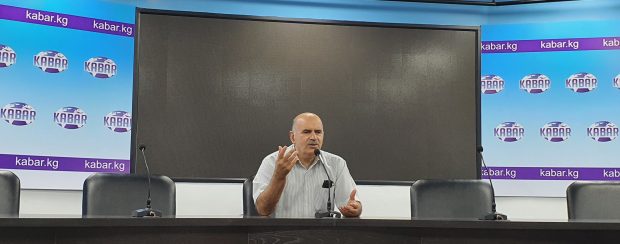Kyrgyzstan among Asia’s top five in World Press Freedom Ranking 2022
类别: All, Asia, Media, News, Society
标签: asia, KABAR, Kyrgyzstan, press-freedom index

At Kabar’s conference room
By Habib Toumi
BISHKEK: The lush greenery is nothing short of spectacular, providing a soothing and refreshing sentiment.
Oak Park, one of Bishkek’s oldest parks, is home to very large trees, an open-air 90-sculpture exhibition, and several important monuments.
I envy the journalists, photographers and the staff working at Kabar News Agency, the official news agency in Kyrgyzstan. It is also the oldest, launched in 1937 under the name of KyrTAG.
The building is old, but there is ample space with the conference room, the jewel of the premises, capable of accommodating several speakers and numerous participants.
Pictures of past directors general of the bastion of official news in the Central Asian country greet visitors and staff as they come off the serpentine stairs taking them to the second floor (first floor in some other countries).
Like most news agencies across the world, there is no real privacy and the staff are sharing large desks or have juxtaposed desks but with generous work surface.
The staff is truly international in its output as Kabar publishes in six languages – Kyrgyz, Russian, English, Arabic, Chinese and Turkish.
Since the late 1980s, diglossia, the asymmetrical use of two languages in various functional spheres within a community, linguistic dominated the behavior of the Kyrgyz establishment.
Time spent in the capital Bishkek and trips to other areas allowed me to see how the attitudes of people towards the Kyrgyz and Russian languages differed depending on the location.
In a country where the implementation of the language policy remains a rather critical issue, Kabar has been able to move forward without being held by linguistic controversies or shackles.
Most of the news posted by Kabar are available in its six languages, which makes it easier for anyone speaking any of the languages to remain updated on the latest events unfolding in the country, the region and elsewhere across the globe.
To its credit, the media in Kyrgyzstan is faring well and enjoys a high level of freedom ranking the freest in Central Asia and among the top in Asia.
In the latest World Press Freedom Index published by Reporters Without Borders (RSF), Kyrgyzstan came 72nd, moving up seven spots over last year when it was 79th and 10 0ver 2020 when it was 82nd globally.
This year, only East Timor (17), Bhutan (33), South Korea (43) and Japan (71) did better in Asia.
For an emerging democracy and at a time when media faces increasing pressure in countries reputed to have longer democratic traditions, Kyrgyzstan seems to be on the right path to develop and consolidate institutional safeguards against media abuses.
The people I met at Kabar gave the impression they are committed to overcoming challenges, improving their work, updating their methods and, while all doing that and more, upholding press freedom.
Kyrgyzstan certainly gives much hope and sense of achievement to fellow Central Asian countries. In 2022, Uzbekistan moved up by 24 spots, from 157 to 133; Kazakhstan leapt from 155 to 122; Tajikistan improved from 162 to 152, and Turkmenistan moved up from 178 to 177.
Elsewhere in Asia, many countries took a dramatic dive in the ranking.
























































